Insurance policies are designed to provide financial protection against unexpected events, but they don’t always cover everything you might need. That’s where insurance riders come in. An insurance rider, also known as an endorsement or amendment, is an optional add-on that allows you to customize your policy to better suit your specific needs. Whether you want to extend coverage for high-value items, add protection for accidental damages, or secure additional benefits, riders give you the flexibility to tailor your insurance plan. In this article, we’ll explore what insurance riders are, how they work, their benefits, and how they can help you create a more comprehensive and personalized insurance policy.
What is an Insurance Rider?
An insurance rider is an optional add-on to a standard insurance policy that allows policyholders to customize their coverage based on specific needs. Also referred to as an endorsement or amendment, a rider modifies the terms of an existing policy by providing additional benefits, increasing coverage limits, or excluding certain risks. These add-ons are commonly used in life, health, home, auto, and business insurance policies to enhance protection without requiring a separate policy. For example, if a homeowner owns expensive jewelry, a scheduled personal property rider can ensure full coverage beyond the limits of a standard policy. While insurance riders often come at an additional cost, they offer a cost-effective way to secure coverage for valuable assets, unique circumstances, or specific risks that may not be covered under a basic insurance plan.
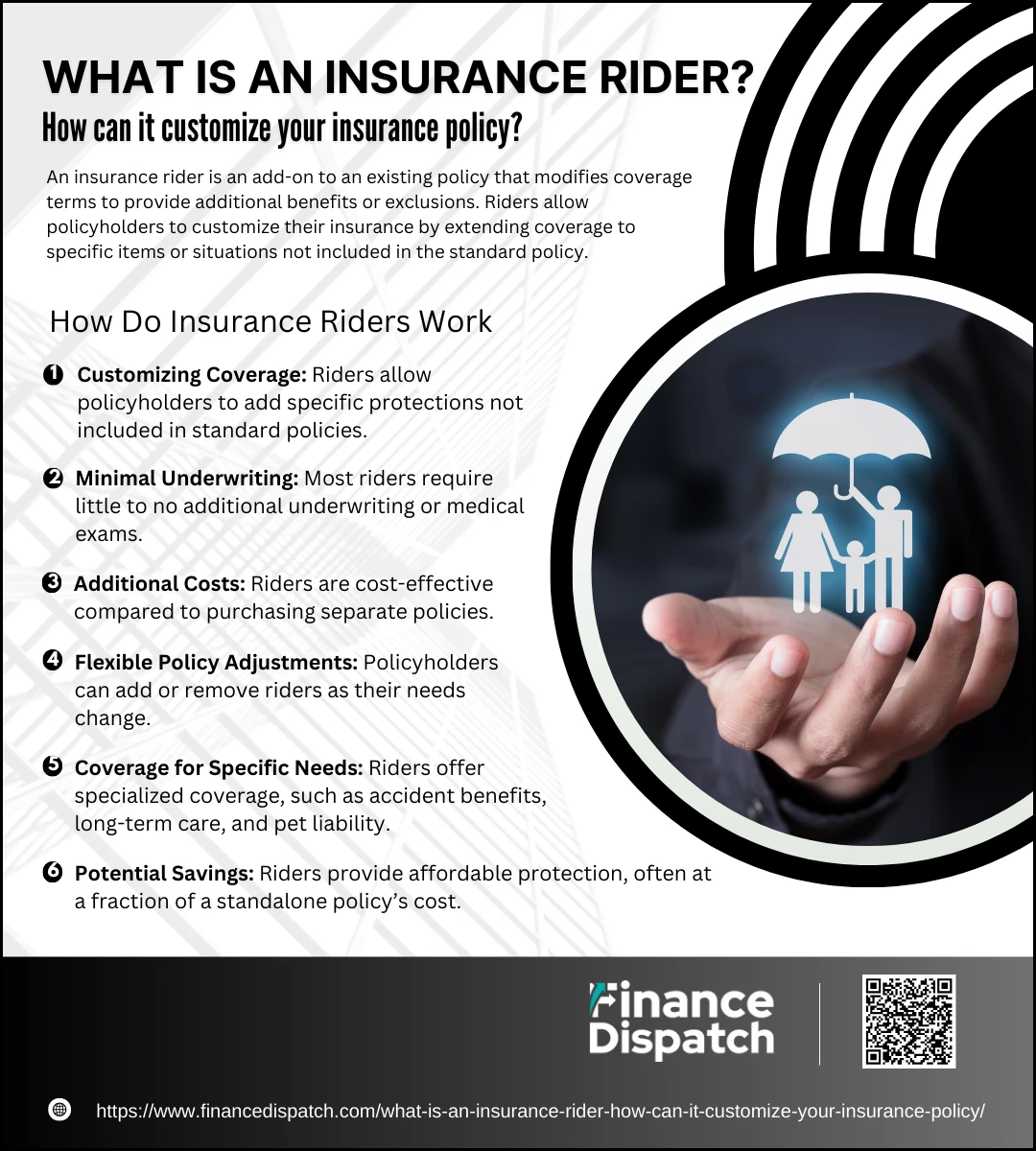 How Do Insurance Riders Work?
How Do Insurance Riders Work?
Insurance riders function as policy enhancements, allowing you to extend, modify, or personalize your coverage beyond the basic provisions of a standard policy. Instead of purchasing a separate insurance plan to cover specific needs, a rider serves as an add-on that provides additional protection at a relatively low cost. These riders are available across different types of insurance, such as life, health, home, and auto policies, giving policyholders the flexibility to tailor their coverage based on their unique requirements. Below is a detailed breakdown of how insurance riders work and their key features.
1. Customizing Coverage
Insurance riders provide a way to customize a policy to better fit individual needs. Standard policies come with predefined coverage limits and exclusions, but riders allow policyholders to add specific protections that might not be included in the base policy. For example, a homeowner’s insurance policy may have a coverage limit for jewelry, but a scheduled personal property rider can extend that limit to fully cover expensive items like engagement rings or antiques. Similarly, a critical illness rider in a life insurance policy can provide additional financial support in case of a severe medical diagnosis.
2. Minimal Underwriting
Unlike standalone policies that require extensive risk assessment and approval, most riders involve minimal underwriting. This means that the process of adding a rider is simpler, faster, and often does not require a detailed medical exam or additional paperwork. For instance, a term conversion rider in a life insurance policy allows a policyholder to convert their term insurance into permanent coverage without undergoing another medical examination, making it a convenient option for those with changing needs.
3. Additional Costs
While riders come at an extra cost, they are generally more affordable than purchasing a separate policy. The cost of a rider depends on factors such as the type of coverage, the insured item’s value, and the insurance provider. For example, a jewelry insurance rider typically costs around $1.50 to $2 per $100 in value, meaning that insuring a $5,000 engagement ring may cost $75 to $100 per year. Despite the additional expense, the cost-effectiveness of riders makes them a popular choice for enhancing coverage without a significant increase in premiums.
4. Flexible Policy Adjustments
Many insurance providers allow policyholders to add or remove riders during the policy term or upon renewal. This flexibility ensures that individuals can update their coverage as their needs evolve. For example, a maternity rider can be added to a health insurance policy before pregnancy and removed later when no longer needed. Similarly, a waiver of premium rider can be added to a life insurance policy to cover future premium payments in case of disability, ensuring continued coverage without financial strain.
5. Coverage for Specific Needs
Insurance riders cater to specific needs that may not be adequately covered under a standard policy. Some common examples include:
- Accidental Death Rider: Provides additional payout if the policyholder dies due to an accident.
- Long-Term Care Rider: Helps cover expenses for assisted living, nursing homes, or home health care.
- Roadside Assistance Rider: Offers towing and emergency services for vehicles.
- Pet Liability Rider: Covers medical expenses or legal fees if a pet causes injury to someone.
These riders ensure that policyholders are protected against risks relevant to their lifestyle and financial goals.
6. Potential Savings
By adding an insurance rider instead of purchasing an entirely new policy, policyholders can save money while obtaining the additional protection they need. Riders typically cost a fraction of the price of a separate policy while still providing substantial benefits. For example, adding an identity theft rider to a home insurance policy is far more cost-effective than purchasing a standalone identity theft protection plan. Additionally, some riders, such as the return of premium rider in a life insurance policy, offer partial refunds if the policyholder outlives the policy term, further enhancing the financial benefits.
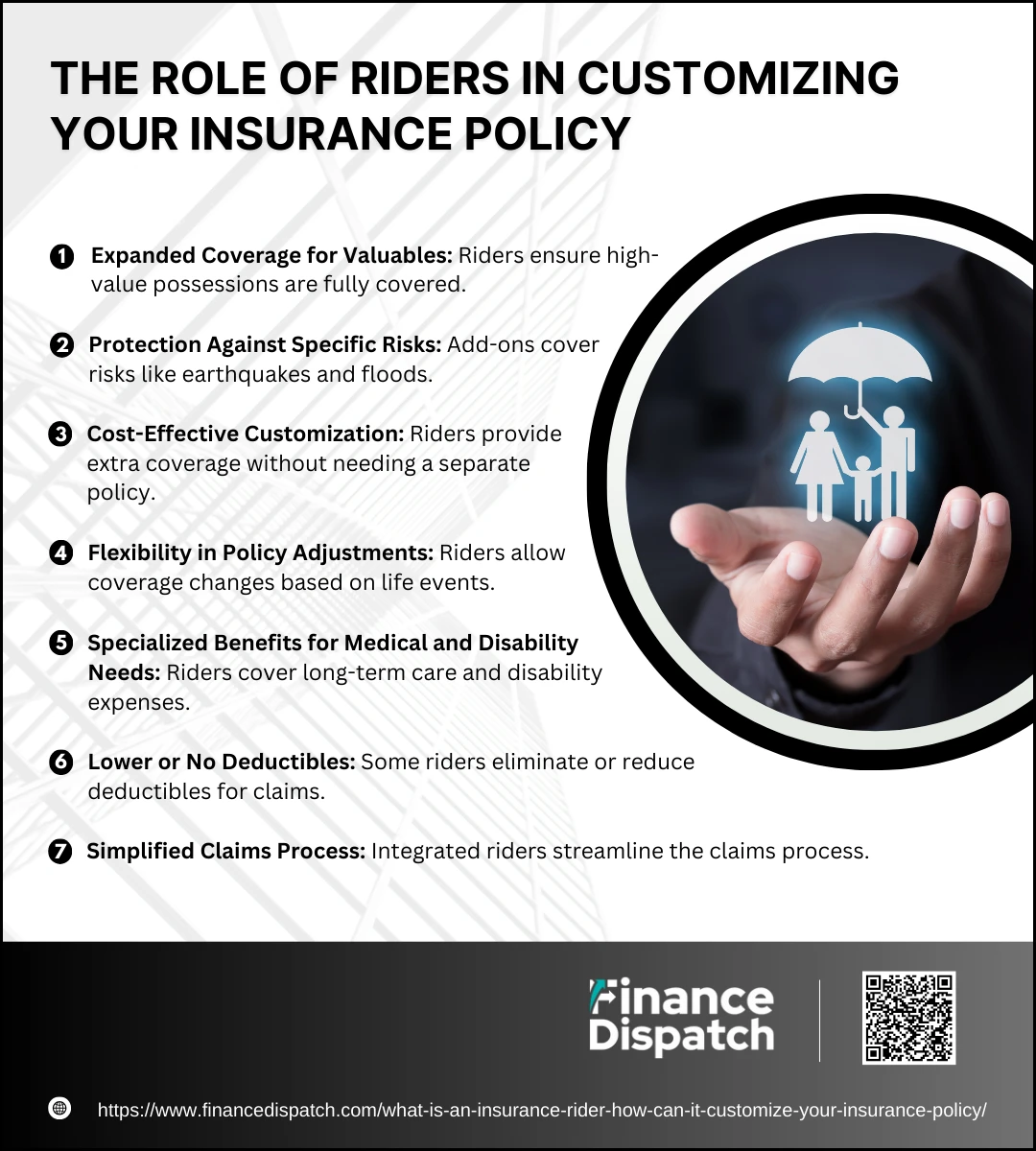 The Role of Riders in Customizing Your Insurance Policy (Bullet List)
The Role of Riders in Customizing Your Insurance Policy (Bullet List)
Insurance policies provide essential financial protection, but they often come with limitations that may not fully cover your unique needs. Insurance riders offer a solution by allowing you to customize your coverage with add-ons that provide extra protection for specific risks, valuable items, or unexpected situations. Rather than purchasing a separate insurance policy, riders allow you to enhance and personalize your existing policy at a relatively low cost. Whether you need additional coverage for medical expenses, high-value possessions, or unforeseen events like disability or long-term care, riders help bridge coverage gaps and ensure financial security.
How Insurance Riders Help Customize Your Policy
1. Expanded Coverage for Valuables
Standard home insurance policies often have coverage limits for expensive belongings like jewelry, art, or collectibles. A scheduled personal property rider ensures these high-value items are fully insured in case of loss, theft, or damage.
2. Protection Against Specific Risks
Standard insurance policies do not always cover natural disasters like earthquakes and floods. Homeowners in high-risk areas can add earthquake or flood riders to their policies for extra protection against these unpredictable events.
3. Cost-Effective Customization
Instead of purchasing a separate policy, adding a rider is typically more affordable while still providing specialized coverage. For example, a critical illness rider can help cover medical expenses if diagnosed with a severe disease without needing a separate health policy.
4. Flexibility in Policy Adjustments
Riders allow you to adjust coverage based on changing life situations. If you get married, have children, or change jobs, you can modify your policy by adding or removing riders such as a spousal rider or a child term rider in life insurance.
5. Specialized Benefits for Medical and Disability Needs
A long-term care rider helps cover nursing home expenses or home healthcare costs, reducing the financial burden on you and your family. Similarly, a waiver of premium rider ensures you don’t have to pay premiums if you become disabled or unable to work.
6. Lower or No Deductibles
Many riders come with low or no deductibles, ensuring a higher payout when you need to file a claim. For instance, a jewelry rider may allow full reimbursement for lost valuables without the high deductible of a standard policy.
7. Simplified Claims Process
Riders are integrated into your existing policy, making it easier to manage claims without the hassle of handling multiple separate insurance plans.
Who Should Consider Adding an Insurance Rider?
Insurance riders are beneficial for individuals who need customized coverage beyond the limits of a standard policy. If you own high-value possessions such as jewelry, antiques, or collectibles, a scheduled personal property rider can ensure these items are fully covered in case of loss or theft. Homeowners living in areas prone to natural disasters like floods or earthquakes should consider adding specific riders to their home insurance to protect against unexpected damages. Similarly, individuals with families dependent on their income may benefit from life insurance riders, such as a waiver of premium rider (which covers policy payments in case of disability) or an accidental death rider (which provides an additional payout in case of accidental death). Those concerned about future medical expenses or long-term care should look into critical illness or long-term care riders, which help cover high healthcare costs without affecting their savings. In short, anyone looking for personalized financial protection should consider adding an insurance rider to fill coverage gaps and enhance their policy’s benefits.
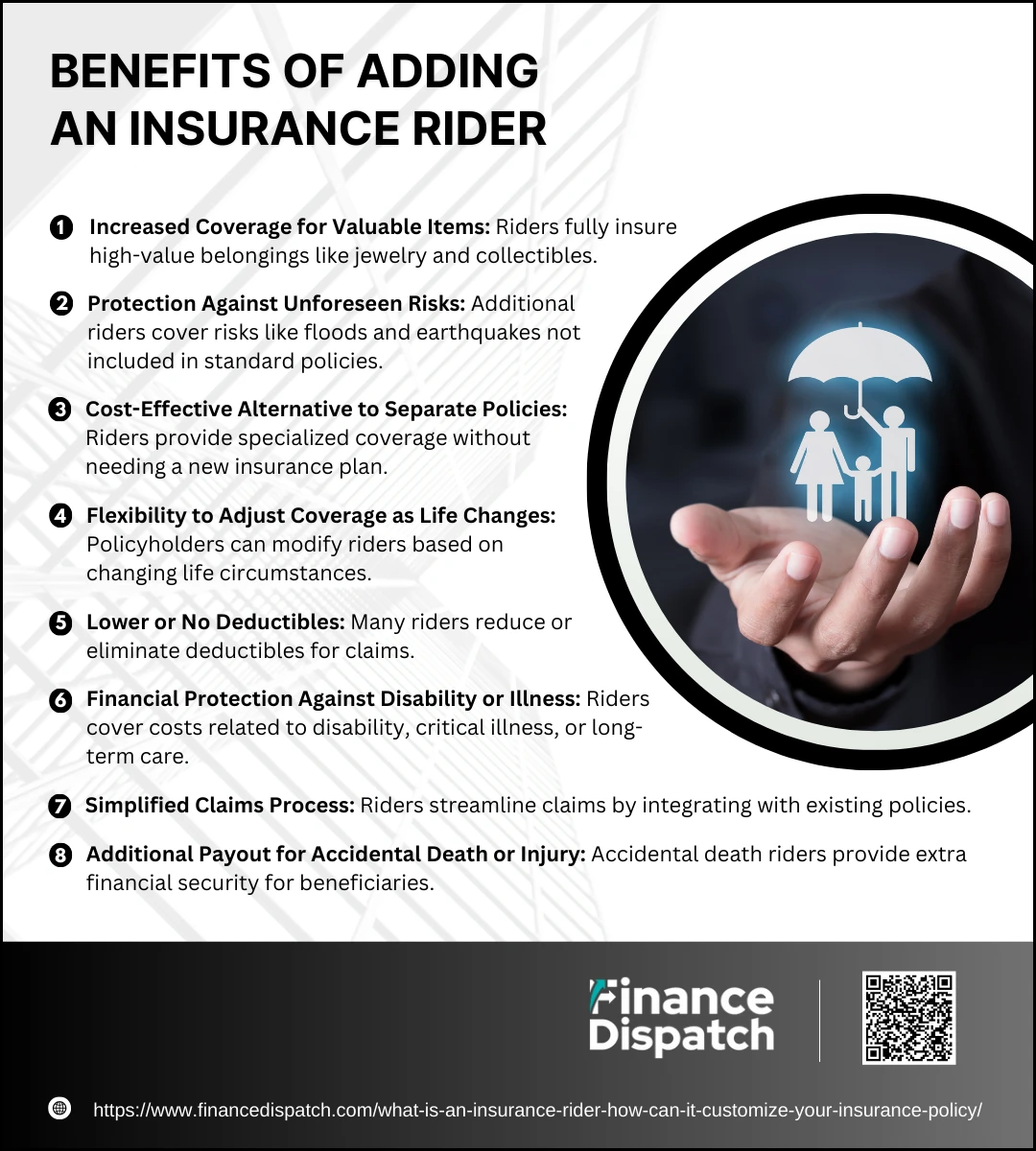 Benefits of Adding an Insurance Rider
Benefits of Adding an Insurance Rider
Insurance riders provide an effective way to customize your policy, ensuring you receive coverage that aligns with your specific needs. Instead of purchasing a separate policy, riders allow you to enhance protection, increase coverage limits, and add specialized benefits at a relatively low cost. Whether you need additional coverage for high-value items, medical emergencies, or accidental damages, riders offer flexibility, affordability, and peace of mind. Below are some key benefits of adding an insurance rider:
1. Increased Coverage for Valuable Items
Standard insurance policies often have limits on coverage for high-value belongings like jewelry, fine art, or collectibles. A scheduled personal property rider ensures these items are fully covered in case of loss, theft, or damage.
2. Protection Against Unforeseen Risks
Not all risks are covered under a basic policy. For example, homeowners in flood-prone areas can add a flood insurance rider to protect against damages that a standard home insurance policy wouldn’t cover.
3. Cost-Effective Alternative to Separate Policies
Adding a rider is more affordable than purchasing an entirely new policy. For example, a critical illness rider in a life insurance policy provides financial support in case of serious illness without the need for a separate health insurance plan.
4. Flexibility to Adjust Coverage as Life Changes
Insurance riders allow policyholders to modify coverage based on changing circumstances. Whether you’re getting married, having children, or changing jobs, you can add or remove riders such as a spousal rider or child term rider in life insurance policies.
5. Lower or No Deductibles
Many riders come with lower deductibles, meaning policyholders receive a higher payout when filing a claim. For example, a jewelry rider may offer full reimbursement without requiring you to pay a high deductible like in a standard policy.
6. Financial Protection Against Disability or Illness
If you become disabled or unable to work, a waiver of premium rider ensures you don’t have to make policy payments, keeping your coverage intact. Similarly, a long-term care rider helps cover assisted living or nursing home costs, reducing the financial burden on you and your family.
7. Simplified Claims Process
Since riders are integrated into your existing policy, they make the claims process smoother compared to managing multiple separate insurance plans. This ensures quick access to funds when needed.
8. Additional Payout for Accidental Death or Injury
A double indemnity rider or accidental death rider provides an extra payout if the policyholder passes away due to an accident, offering greater financial security for beneficiaries.
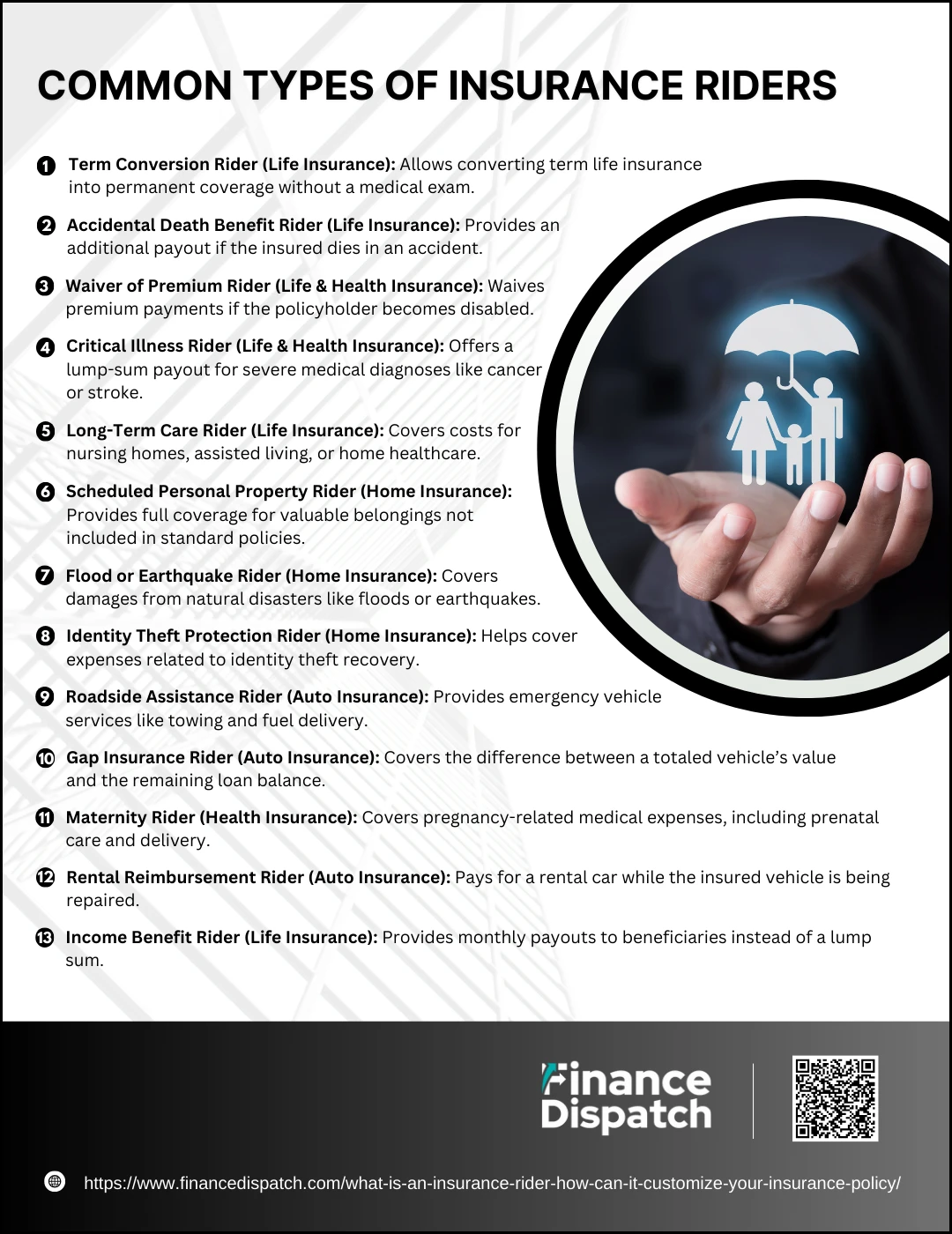 Common Types of Insurance Riders
Common Types of Insurance Riders
Insurance riders allow policyholders to enhance and personalize their coverage based on specific needs. Whether you’re looking for extra protection for high-value items, additional medical benefits, or financial security for your family, there are various types of riders available across different insurance policies. These riders can be added to life, health, home, and auto insurance policies to provide customized coverage without the need for a separate policy. Below are some of the most common types of insurance riders and how they work:
1. Term Conversion Rider (Life Insurance)
Allows policyholders to convert a term life insurance policy into a permanent policy without undergoing a medical exam. This is useful for those who initially purchase affordable term coverage but later decide they need lifelong protection.
2. Accidental Death Benefit Rider (Life Insurance)
Provides an extra payout to beneficiaries if the insured person dies due to an accident. Often referred to as a double indemnity rider, it ensures financial security for loved ones in case of an unexpected fatal accident.
3. Waiver of Premium Rider (Life & Health Insurance)
If the policyholder becomes disabled or unable to work, this rider waives future premium payments while keeping the policy active. It’s particularly helpful for individuals who rely on their income to maintain coverage.
4. Critical Illness Rider (Life & Health Insurance)
Provides a lump-sum payout if the policyholder is diagnosed with a serious illness such as cancer, stroke, or heart disease. This money can be used for medical treatments, loss of income, or daily expenses during recovery.
5. Long-Term Care Rider (Life Insurance)
Covers the cost of assisted living, nursing home care, or in-home healthcare if the policyholder becomes unable to care for themselves. This helps protect savings and ensures financial support for long-term medical needs.
6. Scheduled Personal Property Rider (Home Insurance)
Enhances coverage for high-value items like jewelry, antiques, art, and collectibles that may not be fully covered under a standard home insurance policy. It ensures full reimbursement in case of theft, loss, or damage.
7. Flood or Earthquake Rider (Home Insurance)
Provides coverage for natural disasters like floods and earthquakes, which are not typically included in a standard homeowners insurance policy. This rider is crucial for those living in high-risk areas.
8. Identity Theft Protection Rider (Home Insurance)
Helps cover the costs of identity theft recovery, such as legal fees, credit monitoring, and lost wages. This rider provides financial assistance if personal information is stolen and misused.
9. Roadside Assistance Rider (Auto Insurance)
Covers the costs of towing, battery jump-starts, flat tire changes, and emergency fuel delivery if the insured vehicle breaks down. This rider is helpful for drivers who want 24/7 roadside support.
10. Gap Insurance Rider (Auto Insurance)
Pays the difference between the actual cash value of a totaled or stolen vehicle and the remaining amount on the auto loan or lease. This prevents financial loss if the car’s value depreciates faster than the loan balance.
11. Maternity Rider (Health Insurance)
Covers pregnancy-related medical expenses, including prenatal care, labor, and delivery. Since many standard health insurance plans don’t include maternity coverage, this rider ensures better financial protection for expecting parents.
12. Rental Reimbursement Rider (Auto Insurance)
Pays for a rental car while your vehicle is being repaired after a covered accident. This rider is useful for those who rely on their car for daily transportation.
13. Income Benefit Rider (Life Insurance)
Instead of a lump-sum payout, this rider provides monthly payments to beneficiaries in case of the policyholder’s death. This ensures financial stability for surviving family members by replacing lost income.
How Much Does an Insurance Rider Cost?
The cost of an insurance rider varies depending on the type of rider, the insured item’s value, the insurance provider, and the policyholder’s risk profile. Generally, riders are affordable add-ons that cost significantly less than purchasing a separate policy. Some riders, like accidental death benefit riders, may cost only a few extra dollars per month, while others, such as long-term care riders, can be more expensive due to their extensive coverage. The premium for a rider is usually calculated as a percentage of the base policy or based on the specific coverage amount it provides. Below is a general estimate of the cost of common insurance riders:
Estimated Costs of Common Insurance Riders
| Rider Type | Typical Cost Estimate | How It’s Charged |
| Scheduled Personal Property Rider | $1.50 – $2 per $100 of item value | Based on insured item’s appraised value |
| Accidental Death Benefit Rider | $5 – $10 per month | Flat monthly rate |
| Critical Illness Rider | 1% – 5% of base policy premium | Percentage of life or health insurance premium |
| Long-Term Care Rider | $50 – $500 per year | Based on age, health status, and benefit amount |
| Waiver of Premium Rider | 10% – 15% of base premium | Percentage of life insurance premium |
| Flood or Earthquake Rider | $100 – $500 per year | Based on location and risk factor |
| Roadside Assistance Rider | $20 – $50 per year | Flat annual rate |
| Gap Insurance Rider (Auto) | $200 – $700 per year | Based on loan amount and vehicle value |
| Identity Theft Protection Rider | $25 – $60 per year | Flat annual rate |
| Rental Reimbursement Rider (Auto) | $2 – $15 per month | Based on coverage limit for rental days |
| Income Benefit Rider (Life Insurance) | Varies based on payout amount | Percentage of policy coverage amount |
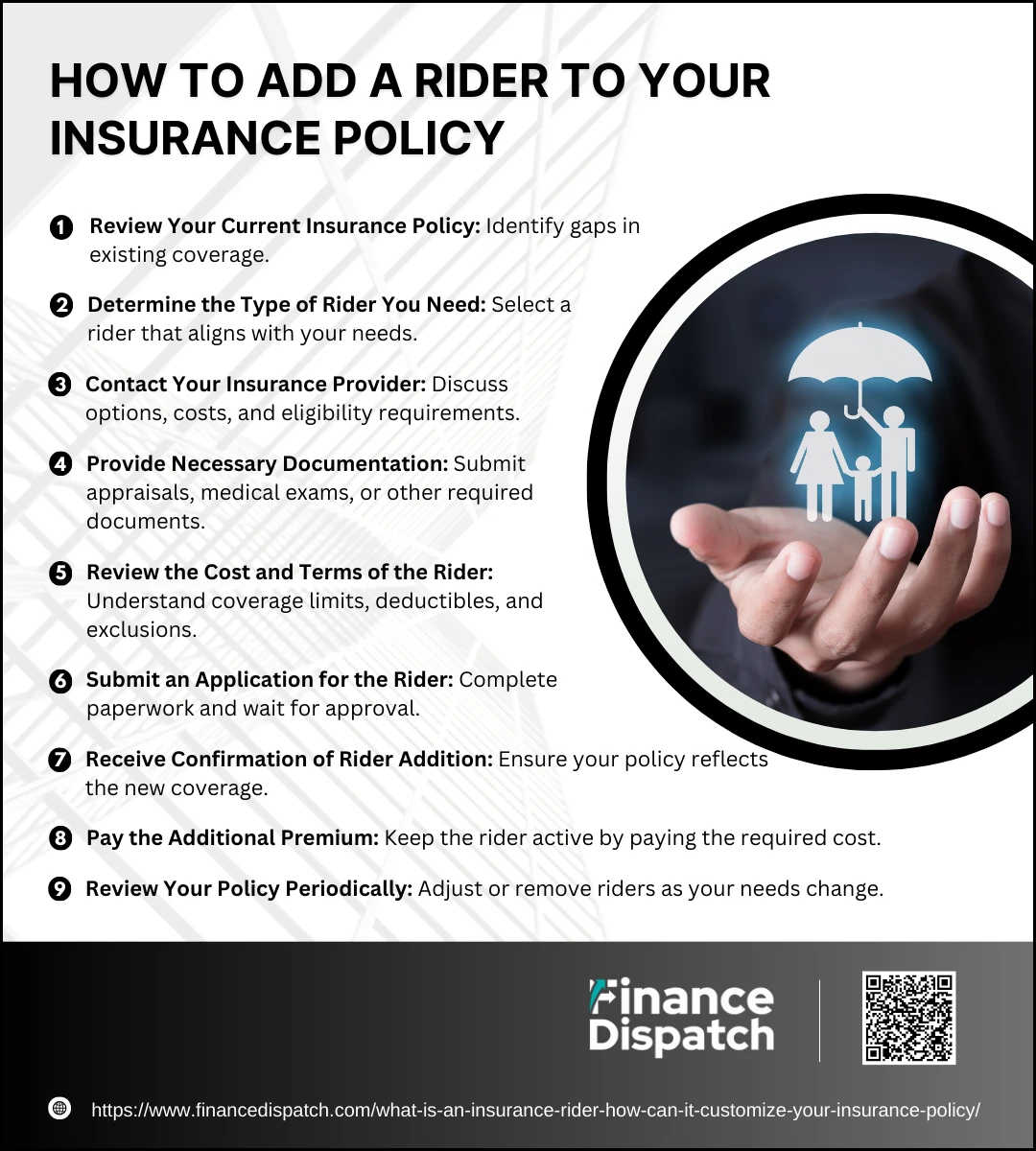 How to Add a Rider to Your Insurance Policy
How to Add a Rider to Your Insurance Policy
Adding a rider to your insurance policy is a simple process that allows you to enhance coverage and tailor your policy to your specific needs. Whether you want to protect high-value items, add financial security for medical emergencies, or extend coverage for unforeseen risks, insurance riders provide a flexible and cost-effective solution. While some riders can be added when purchasing a policy, others may require additional underwriting or documentation. Below are the key steps to add a rider to your insurance policy.
Steps to Add an Insurance Rider
1. Review Your Current Insurance Policy
Start by assessing your existing coverage to identify gaps or areas where additional protection is needed. Check the policy limits, exclusions, and available rider options.
2. Determine the Type of Rider You Need
Based on your coverage needs, choose a suitable rider such as a personal property rider, accidental death rider, or critical illness rider that aligns with your financial and lifestyle requirements.
3. Contact Your Insurance Provider
Reach out to your insurance company or agent to discuss available rider options, eligibility requirements, and premium costs. Some riders may require underwriting, while others can be added instantly.
4. Provide Necessary Documentation
Certain riders, such as scheduled personal property riders, may require an appraisal or proof of ownership. Similarly, health-related riders may require a medical evaluation before approval.
5. Review the Cost and Terms of the Rider
Understand the additional premium, coverage limits, deductibles, and exclusions before finalizing the rider. Compare the cost with the benefits to ensure it’s a valuable addition to your policy.
6. Submit an Application for the Rider
If the rider requires underwriting, submit an application and provide any required details. Some approvals may be instant, while others may take a few days for processing.
7. Receive Confirmation of Rider Addition
Once approved, your insurance provider will update your policy with the new rider. You’ll receive a revised policy document reflecting the additional coverage.
8. Pay the Additional Premium
Riders typically come with an added cost, which may be billed monthly or annually. Ensure you pay the required premium to keep the rider active.
9. Review Your Policy Periodically
Insurance needs change over time. Periodically review your policy and riders to remove unnecessary riders or add new ones based on your evolving circumstances.
Pros and Cons of Insurance Riders
Insurance riders provide a convenient way to enhance and personalize your policy by adding coverage that suits your specific needs. Instead of purchasing a separate policy, riders allow you to extend protection for valuable items, medical emergencies, or accidental damages at a relatively low cost. While they offer numerous benefits, insurance riders also come with limitations, such as additional costs and specific eligibility requirements. Below is a breakdown of the advantages and disadvantages of adding an insurance rider to your policy.
Pros of Insurance Riders
- Customizable Coverage – Riders allow you to tailor your insurance policy to fit your lifestyle, whether it’s extra protection for jewelry, medical expenses, or accidental death benefits.
- Affordable Add-ons – Adding a rider is usually cheaper than buying a separate insurance policy, making it a cost-effective way to enhance coverage.
- Protection for Specific Needs – Riders provide coverage for unique situations that a standard policy may not cover, such as flood insurance, critical illness protection, or long-term care expenses.
- Low or No Deductibles – Many insurance riders have lower deductibles than the base policy, ensuring a higher payout when a claim is filed.
- Flexibility to Modify Coverage – Policyholders can add, remove, or adjust riders as their insurance needs change over time, offering greater flexibility.
- Simplified Claims Process – Riders integrate into the existing policy, making claims easier to process compared to managing multiple standalone insurance policies.
- Financial Security for Family – Life insurance riders like income benefit riders or accidental death riders ensure financial stability for beneficiaries in case of unexpected events.
Cons of Insurance Riders
- Additional Costs – While more affordable than a separate policy, riders still increase the overall premium and may not always be cost-effective.
- Limited Availability – Not all insurance companies offer the same riders, and some policies may restrict eligibility based on health conditions or risk factors.
- Coverage Restrictions – Riders often come with limitations and exclusions, meaning they may not cover all risks policyholders expect.
- Requires Careful Review – Adding too many riders can make your policy complex and difficult to manage, requiring regular reviews to ensure you’re not overpaying for unnecessary coverage.
- May Duplicate Existing Coverage – Some riders, like identity theft protection or roadside assistance, may already be included in other services you use, leading to redundant coverage.
Conclusion
Insurance riders provide a flexible and cost-effective way to customize your policy, ensuring you have the right level of protection for your unique needs. Whether you need extended coverage for valuable assets, financial security for medical emergencies, or additional benefits for your loved ones, riders allow you to enhance your policy without purchasing a separate plan. While they come with added costs and certain limitations, their ability to fill coverage gaps and offer tailored protection makes them a valuable option for many policyholders. To make the most of insurance riders, it’s essential to carefully evaluate your needs, review the costs, and compare available options before making a decision. With the right riders in place, you can enjoy greater financial security and peace of mind, knowing that your policy is designed to meet your specific requirements.



